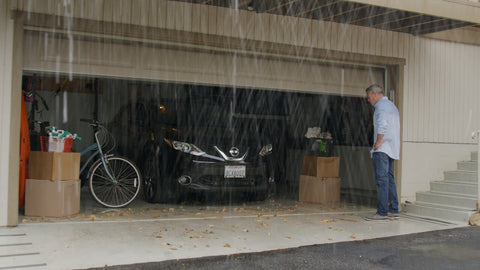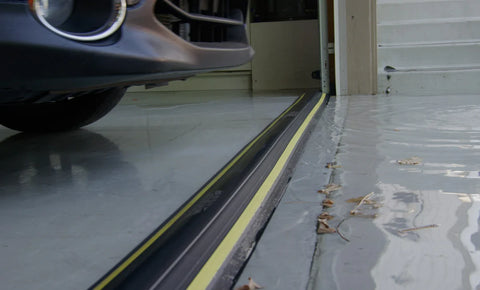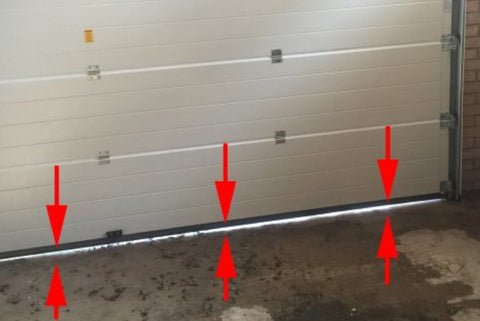How To Seal Bottom Of Uneven Garage Doors
Your garage serves as a haven for your vehicles, tools, and belongings. However, uneven garage floors often lead to gaps under the door, allowing rainwater, debris, cold air, and pests to infiltrate. It's imperative to address these gaps to maintain a secure and comfortable garage space.
Identifying the Problem:
Uneven gaps under garage doors can arise from various issues, including poorly laid concrete or structural settling. Identifying the root cause is crucial for determining the most effective solution.
1. Repair the Concrete Under The Door
In some cases, uneven gaps under the garage door are caused by poorly laid or deteriorating concrete. If the underlying concrete is otherwise sound, it may be possible to apply a layer of screed under the door to create a level surface. If the uneven floor is the result of loose concrete which has developed cracks, a more extensive repair of the concrete base may be required.
A well-laid concrete ‘slab’ will usually have relief cuts at pre-determined intervals to avoid cracking in unwanted areas because of shrinkage and thermal expansion. It is a good idea to consult with an experienced builder to determine the requirements of a new concrete floor in your garage.
Addressing uneven gaps caused by deteriorating or poorly laid concrete is essential. Here's how:
- Assessing Concrete Condition: Examine the condition of the concrete base for cracks, settling, or deterioration.
- Minor Adjustments with Screed: Consider applying a layer of screed to level minor unevenness in the concrete surface.
- Professional Repair: For extensive damage, consult with a professional to carry out repairs, including proper reinforcement and levelling.

2. Install a Floor-Mounted Threshold Seal
Even if your door already has a gasket seal, rubber blade or brush strip, if your garage floor is uneven this will still not create a complete seal. Installing a garage door threshold seal is a convenient and cost-effective way to block a gap between the bottom of your garage door and the floor. A threshold seal provides a robust physical barrier behind the door, like a dam, to block the likes of water, debris and pests.
When the floor under the garage door is uneven, it is important to use a threshold seal that is specifically designed for a variable gap. A ramp-profile threshold seal is best suited to uneven gaps as it can be positioned to sit further forward under the garage door where the gap is larger to maintain a good seal along the inside edge of the door.
GaraDry® garage door thresholds are an excellent choice as they have been designed to solve this exact problem. Made from durable, yet flexible, PVC materials, they can follow any undulations in the floor creating a watertight seal between the bottom of your garage door and the floor.
Bonded to the floor using a specially formulated adhesive and sealant, they can remain in place for many years providing you with an immediate remedy to a common everyday problem.
Even with existing seals, an uneven garage floor may leave gaps. Consider installing a garage door threshold seal:
- Choosing the Right Seal: Select a seal designed to accommodate variable gaps, such as a ramp-profile seal, which can adapt to uneven surfaces.
- Effective Solutions like GaraDry®: Opt for durable and flexible options like GaraDry® garage door thresholds, which effectively block water, debris, and pests.
- Installation Tips: Ensure proper installation using specially formulated adhesive and sealant for long-lasting effectiveness

3. Adjust the Closing Position Of Your Door
Unlike typical up-and-over style garage doors that open as a single piece, sectional and roller garage doors are comprised of multiple articulated panels. Electrically operated sectional and roller garage doors allow the user to adjust the closing position of the door to create good contact between the factory bottom seal and the concrete floor.
By properly adjusting the closing position of your garage door as directed by the manufacturer, you may be able to reduce or eliminate small gaps caused by an uneven floor.
Adjust the Closing Position of Your Door:
For sectional and roller garage doors, adjusting the closing position can improve the seal:
- Following Manufacturer's Instructions: Consult the manufacturer's guidelines to adjust the closing position, ensuring proper contact between the seal and the floor.
- Minimising Gaps: Proper adjustments can help minimise or eliminate gaps caused by uneven floors, enhancing garage security and insulation.

Additional Solutions for Comprehensive Garage Sealing:
In addition to addressing uneven gaps at the bottom of your garage door, consider these solutions for comprehensive garage sealing:
- Garage door Top and Side Seals: Seal gaps around the top and sides of your garage door with specialised seals to prevent air and moisture infiltration.
- Garage Door Insulation kit: Enhance energy efficiency and temperature control in your garage by installing insulation kits designed specifically for garage doors.
Conclusion
In conclusion, there are several effective ways to deal with an uneven gap under your garage door to protect the belongings in your garage. From installing a ramp-profile threshold seal to carrying out remedial work on your concrete floor, sealing the gap under your garage door is a great way to improve the environment inside your garage.
If you require additional help on any of our products or you require advice on sealing your garage, please contact us and we will be happy to help.


